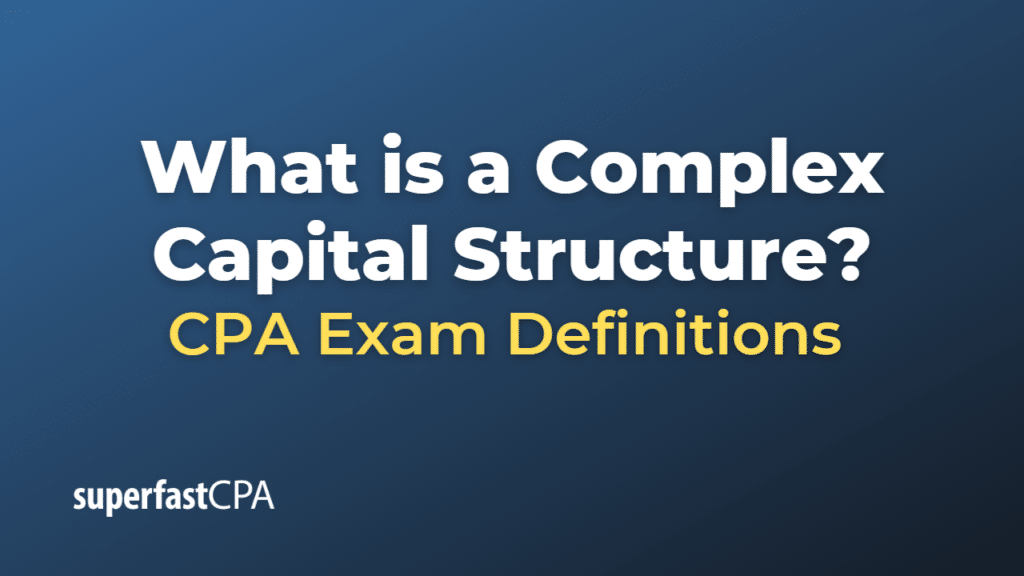Complex Capital Structure
A complex capital structure is a term used to describe the composition of a company’s financing sources that includes a mix of various types of securities, such as common stock, preferred stock, convertible securities, stock options, and warrants. Companies with a complex capital structure have multiple classes of equity and/or debt instruments, which can potentially be converted into common stock or have an impact on the company’s earnings per share (EPS) calculations.
A company with a complex capital structure often has different classes of shareholders, each with its own set of rights, preferences, and claims on the company’s assets and earnings. This complexity can arise due to various reasons, such as raising capital through multiple financing rounds, issuing stock options to employees, or offering convertible securities to attract investors.
The complexity of a company’s capital structure can have implications for its financial reporting and valuation. For instance, when calculating earnings per share (EPS), companies with a complex capital structure must report both basic EPS and diluted EPS. Basic EPS represents the earnings available to common shareholders, divided by the weighted average number of common shares outstanding during the period. Diluted EPS, on the other hand, takes into account the potential dilution effect of convertible securities, stock options, and warrants by assuming that they have been converted into common shares.
A complex capital structure can also impact the valuation of a company, as it may require a more detailed analysis of the various securities and their impact on the company’s future cash flows, risk profile, and overall value. Additionally, a complex capital structure can sometimes make it more challenging for investors to understand and compare the company’s financial performance and value with that of its peers.
Examples of companies with complex capital structures include those with multiple classes of stock (such as Class A and Class B common shares), preferred shares with different dividend rates or conversion features, convertible debt, and outstanding stock options or warrants.
Example of a Complex Capital Structure
Let’s consider a hypothetical technology company, TechCo, which has a complex capital structure as a result of various financing rounds and equity-based compensation for its employees.
TechCo’s capital structure includes the following securities:
- Common Stock: TechCo has two classes of common stock – Class A and Class B. Class A shares have voting rights, while Class B shares have limited voting rights but higher dividend rates. This dual-class structure allows the founders and early investors to maintain control over the company while still raising capital from new investors.
- Preferred Stock: TechCo has issued preferred stock in multiple financing rounds, with each series having different dividend rates, liquidation preferences, and conversion rights. Preferred stockholders have priority over common stockholders in receiving dividends and claiming assets in the event of liquidation.
- Convertible Debt: TechCo has issued convertible bonds to raise capital. These bonds pay interest to bondholders and can be converted into a specified number of common shares at the bondholder’s discretion, usually after a certain period or when specific conditions are met.
- Stock Options and Warrants: TechCo has granted stock options to its employees as part of their compensation package. These options give the employees the right to purchase common shares at a predetermined price (strike price) within a specified period. TechCo has also issued warrants to some investors, which function similarly to stock options but are typically granted to non-employees.
As a result of its complex capital structure, TechCo must consider the potential impact of each type of security on its financial reporting and valuation. For instance, when calculating earnings per share (EPS), TechCo must report both basic EPS (based on the weighted average number of common shares outstanding) and diluted EPS (which takes into account the potential dilution effect of convertible securities, stock options, and warrants).
Additionally, analysts and investors evaluating TechCo’s financial performance and value must take into account the various securities and their associated rights, preferences, and potential impact on the company’s future cash flows and risk profile. This complexity can make it more challenging to understand and compare TechCo’s financial position with that of its peers, which may have simpler capital structures.













